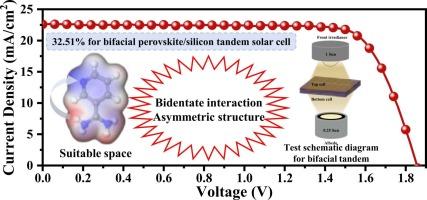Isomer-Engineering of Pyridine Amidinium for Efficient Bifacial Perovskite/Silicon Tandem Solar Cells
IF 17.1
1区 材料科学
Q1 CHEMISTRY, PHYSICAL
引用次数: 0
Abstract
Bifacial perovskite/silicon tandem solar cells (TSCs) exhibit significant performance advantages over their monofacial counterparts under real-world operating conditions, yet their progress is contingent on the development of high-quality wide-bandgap perovskites. Herein, we integrate the benefits of Lewis bases and oversized cations by designing a series of structurally tailored pyridine-functionalized amidinium additives (2PyFA⁺, 3PyFA⁺, and 4PyFA⁺) to systematically explore the impact of ionic configuration on perovskite film properties and device performance. Among them, the meta-configured 3PyFA⁺ demonstrates a unique bidentate anchoring capability: it simultaneously coordinates with Pb2+ and forms hydrogen bonds with I⁻, enabled by its optimal spatial geometry and inductive modulation. This dual-site interaction not only promotes oriented perovskite crystal growth and relieves residual lattice strain, but also induces the formation of low-dimensional perovskites that reduce residual PbI2 and passivate defects. As a result, inverted single-junction 1.6 eV wide-bandgap perovskite solar cells achieved a remarkable power conversion efficiency of 23.53%, alongside excellent photo- and thermal stability. Notably, monolithic bifacial perovskite/silicon TSCs incorporating 3PyFA⁺ attain a record-high power generation density of 32.51 mW cm-2 under typical bifacial illumination - the highest reported value to date for bifacial perovskite/silicon TSCs. This study establishes a new paradigm for additive design via structural isomer engineering and offers practical guidance for the development of efficient and durable bifacial tandem photovoltaics.

高效双表面钙钛矿/硅串联太阳能电池中吡啶酰胺的异构体工程研究
在实际操作条件下,双面钙钛矿/硅串联太阳能电池(tsc)比单面太阳能电池表现出显著的性能优势,但其进展取决于高质量宽带隙钙钛矿的发展。在这里,我们通过设计一系列结构定制的吡啶功能化酰胺类添加剂(2PyFA⁺、3PyFA⁺和4PyFA⁺)来整合Lewis碱和超大阳离子的优点,系统地探索离子构型对钙钛矿薄膜性能和器件性能的影响。其中,元构型3PyFA⁺表现出独特的双牙锚定能力:它与Pb2+同时配位,并与I⁻形成氢键,这是由其最佳的空间几何形状和感应调制实现的。这种双位点相互作用不仅促进了取向钙钛矿晶体的生长,减轻了残余的晶格应变,而且还诱导了低维钙钛矿的形成,减少了残余的PbI2和钝化缺陷。结果表明,倒置单结1.6 eV宽禁带钙钛矿太阳能电池的功率转换效率达到了23.53%,并且具有优异的光稳定性和热稳定性。值得注意的是,在典型的双面照明下,采用3PyFA⁺的单片双面钙钛矿/硅tsc的发电密度达到了创纪录的32.51 mW cm-2,这是迄今为止报道的双面钙钛矿/硅tsc的最高值。本研究通过结构异构体工程为增材设计建立了新的范式,为开发高效、耐用的双面串联光伏材料提供了实践指导。
本文章由计算机程序翻译,如有差异,请以英文原文为准。
求助全文
约1分钟内获得全文
求助全文
来源期刊

Nano Energy
CHEMISTRY, PHYSICAL-NANOSCIENCE & NANOTECHNOLOGY
CiteScore
30.30
自引率
7.40%
发文量
1207
审稿时长
23 days
期刊介绍:
Nano Energy is a multidisciplinary, rapid-publication forum of original peer-reviewed contributions on the science and engineering of nanomaterials and nanodevices used in all forms of energy harvesting, conversion, storage, utilization and policy. Through its mixture of articles, reviews, communications, research news, and information on key developments, Nano Energy provides a comprehensive coverage of this exciting and dynamic field which joins nanoscience and nanotechnology with energy science. The journal is relevant to all those who are interested in nanomaterials solutions to the energy problem.
Nano Energy publishes original experimental and theoretical research on all aspects of energy-related research which utilizes nanomaterials and nanotechnology. Manuscripts of four types are considered: review articles which inform readers of the latest research and advances in energy science; rapid communications which feature exciting research breakthroughs in the field; full-length articles which report comprehensive research developments; and news and opinions which comment on topical issues or express views on the developments in related fields.
 求助内容:
求助内容: 应助结果提醒方式:
应助结果提醒方式:


